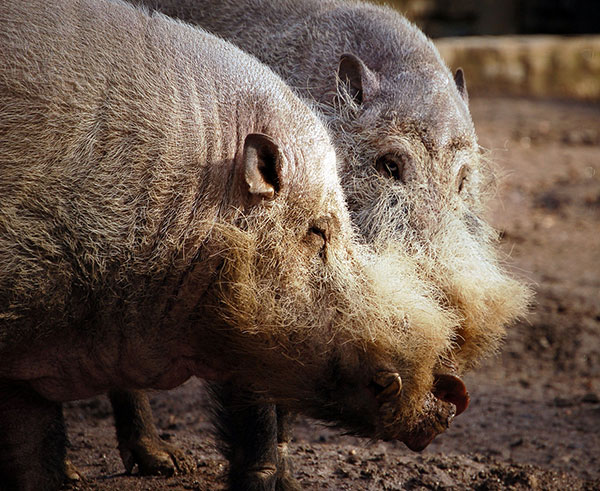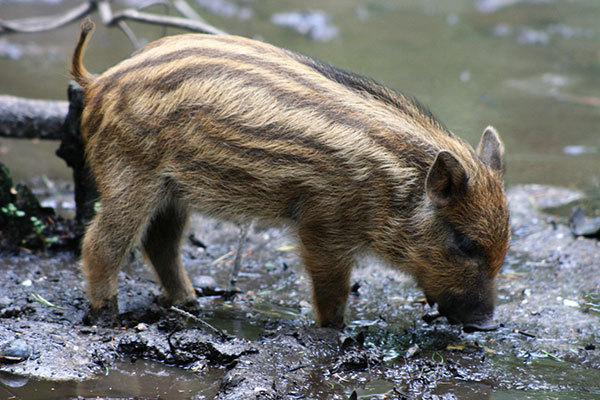
Little is really known about the bearded pig for such is its elusiveness in the rainforest.
THE Suidae family wild pig/boar is scattered all over the globe, in Eurasia, North Africa and the Greater Sunda Islands. It is thought this ungulate and mammal originated in Southeast Asia during the Pleistocene geological period (1.4 million to 11,000 years ago) and during these times migrated into other parts of Eurasia according to food needs. Today, worldwide, 16 subspecies have been identified.
In the wild I have seen bush pigs (warthogs) on the Kenyan savannah grasslands and domesticated pigs in the United Kingdom of all shapes, origins and sizes.
The closest encounter I have ever had with feral pigs is with a bearded pig (Sus borneo barbatus), caught in my head torch, as it was foraging through garbage bins at Danum Valley Rainforest Lodge in Sabah many years ago.
The bearded pig is so called because of tufts of hair up to 15 centimetres long on its snout and cheeks. Long-legged and large, with tusks up to 25 centimetres long, it is indeed a formidable boar.
The Bornean bearded pig
Little is really known about the bearded pig for such is its elusiveness in the rainforest. It is thought that they breed all year round and that mating begins when the forest dipterocarp and oak trees stop flowering. They build large nests up to two metres across.
Piglets are born after a gestation period of between three and six months depending on the age of the sow but always at a time when fruit is plentiful on the overhead trees.
The fruits are dislodged by macaques and orang-utans to hit the forest floor for the bearded pigs’ feasts. What symbiosis.
In years when fruits are plentiful up to two litters of between two and 10 piglets are born.
Each piglet is born with a pale striped camouflage to fade into the forest floor leaf litter. Inevitably, in times of prolonged drought and with forest removal for commercial exploitation, the bearded pigs’ natural habitat suffers and so they move closer to human habitation to raid villagers’ garden plots and garbage bins at night.
Normally, at times of plentiful fruit provision, these pigs are most active in the early morning and late afternoon.
At midday they tend to wallow deep within mud to remove ticks, leaches and to ease mosquito bites before taking a well-earned siesta in their nests when the overhead sun is at its fiercest.
An excellent swimmer, like all boar, occasionally families have been seen to cross rivers, even in crocodile infested waters, to gain better foraging habitats.
They also rid themselves of ticks (tick fever) and scrub typhus. Besides fruit they devour nuts, grass, worms and dead birds and whatever lies in the path of their omnivorous diet.
Here, in Borneo, their main predators are clouded leopards and pythons.
Whilst hunters in the deep forest kill them for local food supplies, the overall numbers of bearded pig still remain high. Sadly in Peninsular Malaysia and Sumatra, a subspecies (Sus barbatus oi) has rapidly declined because of the destruction of its natural habitat.
Unlike domestic pigs, where 70 per cent of their body weight lies in their hindquarters, bearded pigs’ muscles are concentrated in their heads and shoulders to allow them to forage deep in the forest floor.
At mating time this also allows a male to viciously charge at an intruding, inquisitive male in order to protect his harem.

Wild boars are today located in woodlands in six English counties.
Earlier records
Alfred Russel Wallace made little mention of these animals in his late Victorian writings on ‘The Malay Archipelago’ but Robert Shelford (a former curator of Sarawak Museum) in his 1916 posthumously published book ‘A Naturalist in Borneo’ recorded three species of Bornean wild boar.
He noted, in those days, huge migrations of these animals “plunging into rivers, without hesitation, to swim over to the other side”.
He recalled how a naturalist, a certain Ernest Hose, living at Santubong, saw a piglet seized by a python and how other bearded pigs trampled upon and gored the snake with their tusks until the python gave up the ghost. Remarkably the piglet survived its ordeal.
Feral boar in the UK
In 1087 AD, 21 years after he defeated the English at the Battle of Hastings, King William the Conqueror enacted a forestry law forbidding the unlawful killing of wild boar.
No doubt through illegal poaching wild boar eventually became extinct in British oak and beech tree forests. In the 1970s European wild boar (Sus scrofa) were imported to establish boar farming with the meat sold to upmarket restaurants.
Many boar dug deep under the perimeter fences, escaping to the nearest forest where they have continued to breed.
Today wild boars are located in woodlands in six English counties. In the Forest of Dean on the English/ Welsh borderland these animals have proliferated to the annoyance of motorists and local vegetable farmers and gardeners. Compared with the estimated population of Bornean wild pigs, the number of feral boar in the UK is insignificant, however.
Because of the European winters, these boar have long bristled outer coats, which can shed rain and snow with a second layer of fur, almost down-like hair, next to their skin.
Their rutting season is between November and January, when male boar have been seen to fight and maul other males that have wandered into their territory.
All male boar mark their territory with very pungent urine.
These boar survive on acorns, nuts and truffles found on the forest floors at autumn time. Sometimes they graze on ferns and bracken but more often than not forage in farmers’ root vegetable crop fields.
In Britain they have no real predators other than man, in legally culling their numbers. In mainland Europe their chief predators are wolves and commercially organised shooting expeditions.
With rapid urban expansion boar are now seen regularly in some European cities at night devouring the contents of waste bags left on streets. Why? We have only ourselves to blame.
The Year of the Pig
Chinese horoscopes claim that those born in that year take life relatively easily, with polite, noble but emotional attributes.
As a pure Celt, I have recently discovered that my ancestors held wild boar in esteem, seeing them as sacred animals, only to be used in sacrifices to pagan gods but never to be eaten. Today, dieticians claim that boar meat is very much healthier and leaner than domesticated pork.
Fukushima Daiichi nuclear disaster
Since that terrible tsunami in 2011, which overcame that nuclear reactor and its resultant radioactive contamination leading to the evacuation of all people in the fall out zone, this area is now overrun by radioactive wild boar (Sus riukiuanus).
These animals are wandering beyond the exclusion zone to farmers’ fields and peoples’ gardens up to 60km from the site of the nuclear power station’s explosion. There in the last five years, 15,000 wild boar have been humanely culled.
Wherever we live in the world wild boar need our protection and responsible management for without them we would never have our domesticated pigs today.
